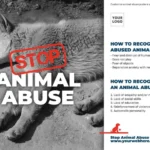In the Garden State, the issue of animal cruelty remains a poignant concern, prompting discussions not only about the ethical treatment of animals but also about the legal ramifications of such heinous acts. Many individuals may wonder: just how serious is the situation regarding animal cruelty charges in New Jersey? What legal penalties await those who commit these acts? Understanding the legal consequences of animal abuse is paramount in our quest for justice and advocacy for our voiceless companions.
New Jersey has made significant strides in its legal framework to protect animals from cruelty. The laws are designed to ensure that offenders face stringent penalties, reflecting society’s collective disdain for animal abuse. This established legal groundwork plays a crucial role in deterring potential abusers and advocating for animal welfare. However, the effectiveness of these laws often hinges upon their enforcement, leaving many to contemplate their actual impact: Are these laws holding perpetrators accountable in a meaningful way, or do they fall short of delivering adequate justice?
Animal cruelty in New Jersey can take various forms, ranging from neglect and abandonment to more overt acts of violence against animals. Recognizing the many ways individuals and organizations can commit acts of cruelty is crucial. Neglect may involve failing to provide necessary care such as food, water, shelter, and medical attention. Conversely, direct violence may manifest as physical harm, torture, or even killing an animal without justifiable cause. Each of these acts constitutes a violation of New Jersey’s animal cruelty statutes, codified under various sections of the New Jersey Statutes Annotated (N.J.S.A).
The severity of the punishment for animal cruelty in New Jersey is contingent upon the classification of the offense. Generally, animal cruelty falls under two categories: “Animal Cruelty” and “Animal Abuse.” The latter is categorized as a disorderly persons offense, while the former can escalate into a fourth-degree crime or, in instances of especially egregious behavior, a third-degree crime.
For cases classified as disorderly persons offenses, the consequences may include monetary fines up to $1,000 and potential jail time of up to six months. However, when the offense reaches the level of fourth-degree crime, penalties become significantly stiffer. Offenders can face fines up to $10,000 and imprisonment for a term of up to 18 months. In scenarios characterized by particularly brutal acts, such as aggravated animal cruelty, a third-degree crime can lead to prison sentences of three to five years and fines ascending to $15,000.
A question looms large: while the penalties sound severe, does the enforcement of these laws reflect an unwavering commitment to the protection of animals? The reality, unfortunately, can be quite complex. Even when laws are in place, the disclosed incarceration rates and penalties still reveal a loophole that can leave victims without the justice they deserve. The lack of consistent enforcement, coupled with public apathy and insufficient law enforcement training, complicates the landscape and raises concerns regarding the efficacy of legal repercussions for animal cruelty.
The challenges extend beyond the judicial system itself. Advocacy groups tirelessly call for increased awareness, better training for law enforcement, and enhanced community outreach. They argue that a concerted effort is necessary for rehabilitating offenders and educating the public about responsible animal care. Yet, the road to reform is often fraught with hurdles. Many believe that societal attitudes towards animal welfare require substantial shifts, highlighting the disconnect between the existence of protective laws and actual public behavior.
Conversely, New Jersey has initiated proactive measures to combat animal cruelty. Legislative proposals, for example, have emerged to empower animal shelters seeking reimbursement for costs incurred while caring for animals during investigations. This type of reform aims to alleviate the financial burden placed on shelters, fostering an environment where they can devote more resources to animal protection, instead of scrambling for funds amid cases of neglect or abuse.
Moreover, community involvement plays a vital role in enhancing animal welfare laws. It is the responsibility of citizens to educate themselves about the signs of animal cruelty and report suspected cases promptly. By remaining vigilant and taking action when witnessing neglect or abuse, the community can serve as the eyes and ears of law enforcement, linking legal ramifications with actionable outcomes.
In conclusion, while New Jersey has established a comprehensive legal framework to combat animal cruelty, the journey to adequate enforcement remains ongoing. The prospect of jail time for animal cruelty serves as a deterrent; however, the effectiveness of these laws often depends on community awareness and law enforcement diligence. It poses a critical question: how can we bridge the gap between legislation and actual accountability? Mobilization, education, and vigilance may be the key drivers in transforming legal deterrents into tangible consequences for abusers, thereby establishing a culture that values and protects the rights of all living beings. Together, we can strive towards an environment where all creatures are treated with the compassion and respect they inherently deserve.





